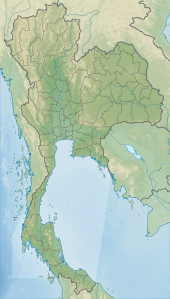Hat Khanom–Mu Ko Thale Tai National Park
| Hat Khanom–Mu Ko Thale Tai National Park | |
|---|---|
| หาดขนอม-หมู่เกาะทะเลใต้ | |
 | |
Map of Thailand | |
| Location | Nakhon Si Thammarat Province, Surat Thani Province |
| Nearest city | Nakhon Si Thammarat |
| Coordinates | 9°13′0″N 99°51′0″E / 9.21667°N 99.85000°E |
| Area | 312 km2 (120 sq mi) |
| Established | Preparation |
| Visitors | 24,456 (in 2019) |
| Governing body | Department of National Parks, Wildlife and Plant Conservation |
Hat Khanom–Mu Ko Thale Tai (Thai: หาดขนอม-หมู่เกาะทะเลใต้) is a national park in the process of being established as of 2015[update]. It is in southern Thailand, covering territory of the districts Khanom and Sichon of Nakhon Si Thammarat Province and Don Sak and Ko Samui of Surat Thani Province.[1]
The name of the park refers to the two major parts of the park. Hat Khanom refers to the beaches of Khanom District, and the Thale Tai archipelago consists of eight islands in the Gulf of Thailand (Ko Mut Tang, Ko Mut Kong, Ko Rap, Ko Hua Ta Khe, Ko Wang Nai, Ko Wang Nak, Ko Noi, and Ko Ta Rai, all in the Sichon and Khanom District, Nakhon Si Thammarat Province, and Ko Samui District, Surat Thani) between Khanom and Ko Samui.
Geography[edit]
The area of the park is 194,797 rai ~ 312 square kilometres (120 sq mi).[2] Most of the area is covered with primary forest which is the provenance of many creeks. The park contains limestone mountains and mangrove forests.
Climate[edit]
Southwesterly and northeasterly winds result in rainfall almost all year round. There are two seasons, summer (February–April) and rainy season (May–January).[1]
Flora and fauna[edit]
Primary forests consist of plants such as Intsia palembanica, Dipterocarpus species, Ironwood, Sandoricum koetjape and Indian oak. Mangrove forests with valuable plants such as mangroves, taboon and Thespesia populneoides. Limestone mountain contain plants such as chanpah and Opuntia elatior.
Mammals – Sus scrofa (wild pig), monkey, semno, squirrel, Menetes berdmorei (Indochinese ground squirrel), Naemorhedus sumatraensis, Muntiacus muntjak, Ursus malayanus, tiger, sambar, gibbon, and Malayan sun bear. Birds – Spilornis cheela (crested), Treron curvirostra (thick-billed pigeon), Copsychus saularis (Oriental), shama, dove, cormorant, Nicobar pigeon, seagull, Egretta sacra (Pacific reef egret) and Ducula aenea (green imperial) Reptiles – tortoise, snakes and chameleon. Amphibians – different kinds of frogs, Bufo asper. Other aquatic life – Channa striatus (serpenthead), crab, shrimp, saltwater fish, soro brook carp, and snakeheads.
See also[edit]
References[edit]
- ^ a b "Hat Khanom - Mu Ko Thale Tai National Park". Department of National Parks (Thailand). Archived from the original on 25 February 2016. Retrieved 4 November 2015.
- ^ "ข้อมูลพื้นที่อุทยานแห่งชาติ (เตรียมการ) 22 แห่ง" [Information of 22 National Parks Areas (Preparation)]. Department of National Parks, Wildlife and Plant Conservation (in Thai). December 2020. Retrieved 1 November 2022, no. 16
{{cite web}}: CS1 maint: postscript (link)

